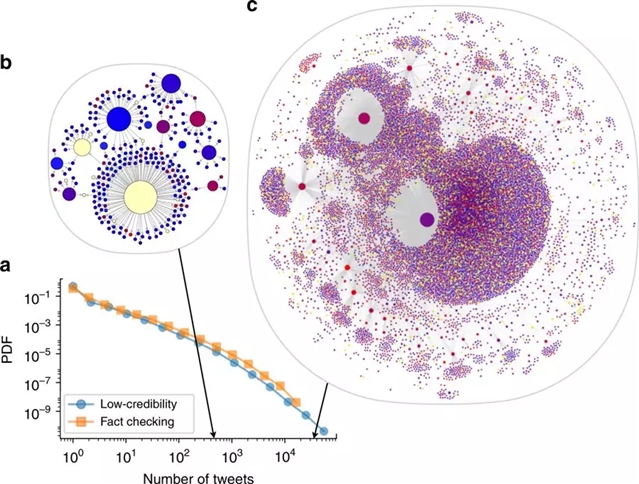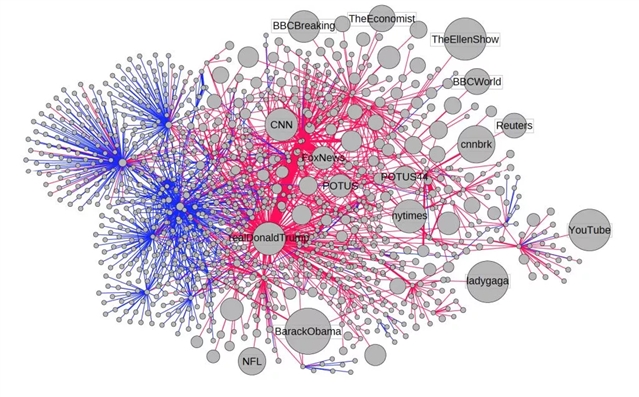|
|
|
|
|
社交网站假消息满天飞的背后,有社交机器人在推波助澜 |
|
|
论文标题:The spread of low-credibility content by social bots
期刊:Nature Communications
作者:Chengcheng Shao, Giovanni Luca Ciampaglia, Onur Varol, Kai-Cheng Yang, Alessandro Flammini, Filippo Menczer
发表时间:2018/11/20
数字识别码: 10.1038/s41467-018-06930-7
原文链接:https://www.nature.com/articles/s41467-018-06930-7?utm_source=other&utm_medium=other&utm_content=null&utm_campaign=JRCN_2_RL_
sciencenet_article_10.1038_s41467-018-06930-7&error=cookies_not_supported&code=16a2b243-39bd-4b20-b2fa-d456218f1026
微信链接:https://mp.weixin.qq.com/s/5cVsyzQin0Ooa5o3cZbjUg
《自然-通讯》发表的一项围绕2016年美国总统大选的研究The spread of low-credibility content by social bots指出,推特(Twitter)上的社交机器人(由软件控制的社交媒体帐户)在低可信度来源文章的传播中起到了很大作用。作者认为,限制社交机器人或能减少网上错误信息的传播。

图源:Pixabay
许多人认为社交机器人对在社交媒体上传播、推广低可信度来源文章的问题上负有重大责任,并要求相关平台对其实施打击,不过迄今为止并未找到确凿证据。

图2:线上内容的病毒式传播。图源:Shao 等
美国印第安纳大学伯明顿分校的Filippo Menczer及同事分析了推特上1400万条推文,这些推文在2016年美国总统大选期间(2016年5月中旬至2017年3月)共转发了40万篇文章。作者发现,社交机器人经常会在低可信度来源(经常发表各类错误信息的网站,这些网站由信誉较好的第三方新闻和事实核查组织确认)的文章发表后和疯传前进行大量传播。
社交机器人还会通过回复和提到功能,将目标指向那些粉丝众多的影响力用户。作者认为这种策略之所以取得成功,是因为人类较易受到这类操控的影响,进而转发一些社交机器人发布的内容。作者通过分析发现,如果在所研究期间封禁一小部分(约10%)最像社交机器人的账号,几乎能消除低可信度内容链接的传播。

图3:图片显示了一篇文章的传播,该文章声称有300万非法移民在2016年美国总统大选中投票。蓝线表示文章通过转推和引推传播,红线表示回复和提到。图源:Filippo Menczer, Indiana University
摘要:The massive spread of digital misinformation has been identified as a major threat to democracies. Communication, cognitive, social, and computer scientists are studying the complex causes for the viral diffusion of misinformation, while online platforms are beginning to deploy countermeasures. Little systematic, data-based evidence has been published to guide these efforts. Here we analyze 14 million messages spreading 400 thousand articles on Twitter during ten months in 2016 and 2017. We find evidence that social bots played a disproportionate role in spreading articles from low-credibility sources. Bots amplify such content in the early spreading moments, before an article goes viral. They also target users with many followers through replies and mentions. Humans are vulnerable to this manipulation, resharing content posted by bots. Successful low-credibility sources are heavily supported by social bots. These results suggest that curbing social bots may be an effective strategy for mitigating the spread of online misinformation.
阅读论文全文请访问:https://www.nature.com/articles/s41467-018-06930-7?utm_source=other&utm_medium=other&utm_content=null&utm_campaign=JRCN_2_
RL_sciencenet_article_10.1038_s41467-018-06930-7&error=cookies_not_supported&code=16a2b243-39bd-4b20-b2fa-d456218f1026
期刊介绍:Nature Communications (https://www.nature.com/ncomms/) is an open access journal that publishes high-quality research from all areas of the natural sciences. Papers published by the journal represent important advances of significance to specialists within each field.
The 2017 journal metrics for Nature Communications are as follows:
•2-year impact factor: 12.353
•5-year impact factor: 13.691
•Immediacy index: 1.829
•Eigenfactor® score: 0.92656
•Article Influence Score: 5.684
•2-year Median: 8
(来源:科学网)
特别声明:本文转载仅仅是出于传播信息的需要,并不意味着代表本网站观点或证实其内容的真实性;如其他媒体、网站或个人从本网站转载使用,须保留本网站注明的“来源”,并自负版权等法律责任;作者如果不希望被转载或者联系转载稿费等事宜,请与我们接洽。